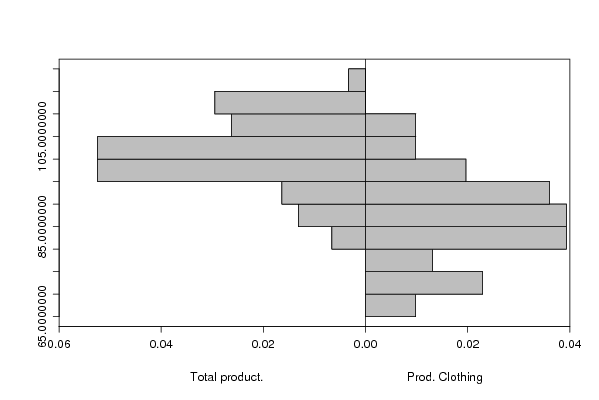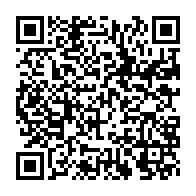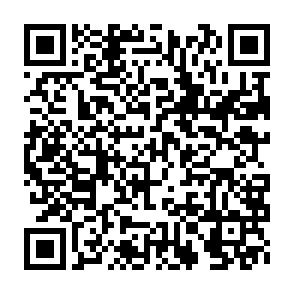Free Statistics
of Irreproducible Research!
Description of Statistical Computation | ||||||||||||||||||||||||||
|---|---|---|---|---|---|---|---|---|---|---|---|---|---|---|---|---|---|---|---|---|---|---|---|---|---|---|
| Author's title | ||||||||||||||||||||||||||
| Author | *The author of this computation has been verified* | |||||||||||||||||||||||||
| R Software Module | rwasp_backtobackhist.wasp | |||||||||||||||||||||||||
| Title produced by software | Back to Back Histogram | |||||||||||||||||||||||||
| Date of computation | Sun, 19 Oct 2008 04:43:59 -0600 | |||||||||||||||||||||||||
| Cite this page as follows | Statistical Computations at FreeStatistics.org, Office for Research Development and Education, URL https://freestatistics.org/blog/index.php?v=date/2008/Oct/19/t1224413168j7cl50ht1uzpfdm.htm/, Retrieved Tue, 14 May 2024 14:28:15 +0000 | |||||||||||||||||||||||||
| Statistical Computations at FreeStatistics.org, Office for Research Development and Education, URL https://freestatistics.org/blog/index.php?pk=16740, Retrieved Tue, 14 May 2024 14:28:15 +0000 | ||||||||||||||||||||||||||
| QR Codes: | ||||||||||||||||||||||||||
|
| ||||||||||||||||||||||||||
| Original text written by user: | ||||||||||||||||||||||||||
| IsPrivate? | No (this computation is public) | |||||||||||||||||||||||||
| User-defined keywords | ||||||||||||||||||||||||||
| Estimated Impact | 187 | |||||||||||||||||||||||||
Tree of Dependent Computations | ||||||||||||||||||||||||||
| Family? (F = Feedback message, R = changed R code, M = changed R Module, P = changed Parameters, D = changed Data) | ||||||||||||||||||||||||||
| F [Back to Back Histogram] [Q2 Total / Clothi...] [2007-10-18 10:14:23] [b731da8b544846036771bbf9bf2f34ce] F D [Back to Back Histogram] [Task 1 - Q2 - Bac...] [2008-10-19 10:43:59] [dafd615cb3e0decc017580d68ecea30a] [Current] F [Back to Back Histogram] [investigating ass Q2] [2008-10-20 23:01:21] [b641c14ac36cb6fee377f3b099dcac19] | ||||||||||||||||||||||||||
| Feedback Forum | ||||||||||||||||||||||||||
Post a new message | ||||||||||||||||||||||||||
Dataset | ||||||||||||||||||||||||||
| Dataseries X: | ||||||||||||||||||||||||||
110.40 96.40 101.90 106.20 81.00 94.70 101.00 109.40 102.30 90.70 96.20 96.10 106.00 103.10 102.00 104.70 86.00 92.10 106.90 112.60 101.70 92.00 97.40 97.00 105.40 102.70 98.10 104.50 87.40 89.90 109.80 111.70 98.60 96.90 95.10 97.00 112.70 102.90 97.40 111.40 87.40 96.80 114.10 110.30 103.90 101.60 94.60 95.90 104.70 102.80 98.10 113.90 80.90 95.70 113.20 105.90 108.80 102.30 99.00 100.70 115.50 | ||||||||||||||||||||||||||
| Dataseries Y: | ||||||||||||||||||||||||||
109.20 88.60 94.30 98.30 86.40 80.60 104.10 108.20 93.40 71.90 94.10 94.90 96.40 91.10 84.40 86.40 88.00 75.10 109.70 103.00 82.10 68.00 96.40 94.30 90.00 88.00 76.10 82.50 81.40 66.50 97.20 94.10 80.70 70.50 87.80 89.50 99.60 84.20 75.10 92.00 80.80 73.10 99.80 90.00 83.10 72.40 78.80 87.30 91.00 80.10 73.60 86.40 74.50 71.20 92.40 81.50 85.30 69.90 84.20 90.70 100.30 | ||||||||||||||||||||||||||
Tables (Output of Computation) | ||||||||||||||||||||||||||
| ||||||||||||||||||||||||||
Figures (Output of Computation) | ||||||||||||||||||||||||||
Input Parameters & R Code | ||||||||||||||||||||||||||
| Parameters (Session): | ||||||||||||||||||||||||||
| par1 = grey ; par2 = grey ; par3 = TRUE ; par4 = Total product. ; par5 = Prod. Clothing ; | ||||||||||||||||||||||||||
| Parameters (R input): | ||||||||||||||||||||||||||
| par1 = grey ; par2 = grey ; par3 = TRUE ; par4 = Total product. ; par5 = Prod. Clothing ; par6 = ; par7 = ; par8 = ; par9 = ; par10 = ; par11 = ; par12 = ; par13 = ; par14 = ; par15 = ; par16 = ; par17 = ; par18 = ; par19 = ; par20 = ; | ||||||||||||||||||||||||||
| R code (references can be found in the software module): | ||||||||||||||||||||||||||
if (par3 == 'TRUE') par3 <- TRUE | ||||||||||||||||||||||||||





